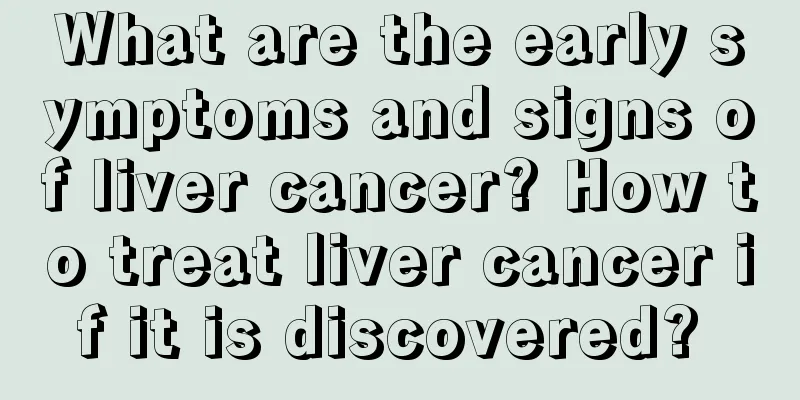What are the early symptoms and signs of liver cancer? How to treat liver cancer if it is discovered?

|
When liver cancer develops to the later stage, it may manifest as weight loss, fatigue, and severe pain, and the cure rate is extremely low. Therefore, it is particularly important to understand the early symptoms and treatment methods, which is related to the patient's life. I hope you can read the following article carefully. What are the early symptoms and signs of liver cancer? 1. Central necrosis of cold-heat type liver cancer can cause fever, and patients with advanced liver cancer may have irregular moderate fever. 2. Internal bleeding or rupture of the surface of the cancerous nodule in abdominal-type liver cancer can cause acute abdominal pain or intra-abdominal hemorrhage. Common rupture of liver cancer at the top of the right lobe of the liver causes pain in the right lower chest, right shoulder and back, and the pain worsens when turning the body position or breathing. Those that penetrate into the abdominal cavity may cause hemorrhagic shock. 3. Early symptoms of liver cancer, typical clinical liver cancer is asymmetric enlargement of the liver, hard and irregular texture, and rapid growth. Late-stage patients often have obvious cirrhosis, portal hypertension, ascites, jaundice, and cachexia. People with a history of hepatitis, HBsAg (+), have aggravated pain in the upper abdomen and liver area before seeing a doctor, especially after meals, accompanied by loss of appetite, weight loss, and lack of energy; 4. Symptoms of liver cancer: Early liver cancer, early or subclinical liver cancer, small tumors, often in hidden locations, patients often have no symptoms, and are only discovered accidentally during physical examinations. Patients may have some non-specific manifestations, such as upper abdominal discomfort and fullness. 5. Differential diagnosis of primary liver cancer and gastrointestinal bleeding: Gastrointestinal bleeding is often the cause of death from advanced liver cancer. 6. Jaundice. Jaundice is a major symptom of liver cancer. The cause of jaundice is that the liver cancer tissue beside the bile duct penetrates into the bile duct to form a tumor thrombus, which grows downward and blocks the opening of the opposite hepatic duct or the common bile duct. The tumor thrombus is often accompanied by bleeding, causing biliary colic. A definite space-occupying lesion can be found from CT scan, but intermittent upper abdominal pain and obstructive jaundice may occur, and sometimes it may be painless and persistent obstructive jaundice. So what should we do if we find liver cancer? How can we treat it? Surgical resection is still the first choice for the treatment of liver cancer. Early resection is the key to improving the survival rate. The smaller the tumor, the higher the five-year survival rate. The indications for surgery are: ① patients with a clear diagnosis and estimated lesions limited to one lobe or half of the liver; ② patients without obvious jaundice, ascites or distant metastasis; ③ patients with good liver function compensation and thrombin time not less than 50%; ④ patients with tolerance of heart, liver and kidney function. In patients with normal liver function, the amount of liver resection shall not exceed 70%; in patients with moderate cirrhosis, the amount of liver resection shall not exceed 50%, or only the left half of the liver can be resected; in patients with severe cirrhosis, no liver lobectomy can be performed. Surgery and pathology have confirmed that more than 80% of liver cancer is combined with cirrhosis. It is generally recognized that local resection instead of regular liver lobectomy has the same effect, and liver function disorders are alleviated after surgery, and the surgical mortality rate is also reduced. Since radical resection still has a relatively high recurrence rate, it is advisable to regularly review AFp and ultrasound imaging after surgery to monitor recurrence. Due to the close follow-up after radical resection, small liver cancers that recur in the "subclinical stage" are often detected, so reoperation is the first choice. The five-year survival rate after the second operation can still reach 38.7%. Although liver transplantation is a method for treating liver cancer and there are many reports abroad, its status in the treatment of liver cancer has not been confirmed for a long time. The long-term use of immunosuppressants after surgery often causes patients to die from recurrence. For developing countries, it is still difficult to promote it in recent years due to the source of donors and cost issues. In addition, there are many treatments for liver cancer, such as chemotherapy, radiation, intervention, medication and other treatments, which can serve as good auxiliary treatments for liver cancer. The specific treatment method to be adopted needs to be decided based on personal circumstances. |
Recommend
Can wormwood and salt relieve itching?
Mugwort is also known as wormwood leaves. Adding ...
How about sunscreen for baby face
I believe everyone knows that Haiermian is a high...
What are the treatments for Achilles tendinitis?
Achilles tendonitis is often caused by improper e...
What are some tips for sore lips?
Mouth rot is a very common phenomenon in life. Ma...
What should I do if my double eyelids become inner double eyelids after double eyelid surgery?
In real life, double eyelids are what many people...
Is the dull pain in the left upper abdomen for 2 months stomach cancer?
If no gastric lesions are found or their patholog...
Teacher's Health Tips for Traditional Chinese Medicine in Summer
Health preservation is a favorite choice of many ...
Is kidney rupture serious?
The kidney is an important organ in the human bod...
What is the normal blood pressure at the age of 26
Although many people have heard about the harm th...
What are the dietary treatments for ovarian cancer
In recent years, ovarian cancer has become one of...
Acne Treatment with White Vinegar and Salt
White vinegar and salt can improve skin keratin a...
What can’t be eaten with curry
Curry is a very popular food in Southeast Asia. M...
Diagnosis of laryngeal cancer
Laryngeal cancer accounts for about 1% to 2% of a...
Is liver cancer hereditary? Pay attention to a few details in life to stay away from liver cancer
Liver cancer is the third most common malignant t...
Preparation of blood smear
Blood smear is a very important method for examin...









